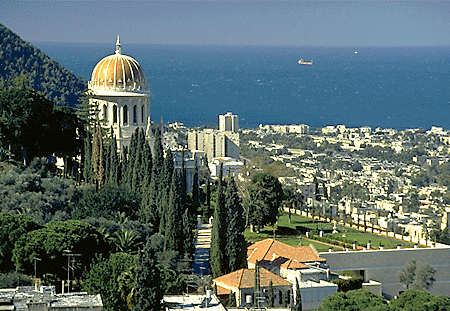
Shrine of the Báb and new terrace

Pilgrimage is a privilege and an obligation in the Bahá'í Faith for those who can afford it. It is enjoined by Bahá'u'lláh in his most important work, the Kitáb-i-Aqdas (Most Holy Book), his Book of Laws.[12] There are three places to which pilgrimage is binding. The first of these is the former residence of the Báb (1819-1850), the prophet-founder of the Bábí religion, in Shiraz, Iran. The Báb was the forerunner of Bahá'u'lláh, and the Bábí and Bahá'í religions are intimately related.[13] The Báb's residence was demolished during the Islamic Revolution in Iran and has not yet been rebuilt. The second place of pilgrimage is the former residence of Bahá'u'lláh during his banishment and exile in Baghdad. Pilgrimages to Shiraz and Baghdad have been suspended due to conditions unfavorable to Bahá'ís in those lands. The third place of obligatory pilgrimage is the Shrine of Bahá'u'lláh at Bahjí.
The purpose of pilgrimage to the Holy Land is to pray at the Shrine of Bahá'u'lláh and, to a lesser extent, the Shrine of the Báb (see below). On the first day the pilgrims visit the Shrine of the Báb. From the second day onwards, the pilgrims visit the sites roughly in a descending order of spiritual significance, starting with the Shrine of Bahá'u'lláh. Although there is no ritual associated with Bahá'í pilgrimages, there are some practices which are quite common amongst the Bahá'ís. Circumambulation of the shrines and recitation of the Tablet of Visitation (see appendix) are two such practices.
Bahá'í pilgrimages began during the period of Bahá'u'lláh's banishment in Adrianople. Following the formal proclamation of his message to the Christian and Muslim rulers of the earth in 1867, Bahá'u'lláh asked one of the well-known Bahá'ís, Nabíl-i-A`zam, to go on pilgrimage.[14] Shoghi Effendi writes,
It was during those same days that Bahá'u'lláh instructed this same Nabíl to recite on His behalf the two newly revealed Tablets of the Pilgrimage, and to perform, in His stead, the rites prescribed in them, when visiting the Báb's House in Shíráz and the Most Great House in Baghdád -- an act that marks the inception of one of the holiest observances, which, in a later period, the Kitáb-i-Aqdas was to formally establish.[15]
Much change has taken place since the first pilgrims visited Bahá'u'lláh in prison in 1868. Pilgrimage then was a dangerous experience. By 1944, Shoghi Effendi was able to note,
we can even bear witness to the marked improvement in the conditions surrounding the pilgrimages performed by its devoted adherents to its consecrated shrines at its world center -- pilgrimages originally arduous, perilous, tediously long, often made on foot, at times ending in disappointment, and confined to a handful of harassed Oriental followers, gradually attracting, under steadily improving circumstances of security and comfort, an ever swelling number of new converts converging from the four corners of the globe, and culminating in the widely publicized yet sadly frustrated visit of a noble Queen [Marie of Rumania], who, at the very threshold of the city of her heart's desire, was compelled, according to her own written testimony, to divert her steps, and forego the privilege of so priceless a benefit.[16]
Today, Bahá'í pilgrimages can be arranged by contacting the appropriate department of the Bahá'í World Centre. Pilgrims converge in the Holy Land from all parts of the world. At present, pilgrimages last nine days. Special arrangements are made at the Bahá'í World Centre to provide local transportation to the Bahá'í properties and to ensure that the pilgrims receive guidance and explanations about the histories of the various sites. Every effort is made to enrich to the utmost these especially auspicious days in the lives of the Bahá'í pilgrims.
The future is expected to lead to a fuller and richer pilgrimage experience. Although pilgrimages to Iraq and Iran are at present impossible, the Bahá'ís are optimistic, and hope that one day the situation will change. The Bahá'í Faith is also growing very rapidly, and the number of pilgrims is very likely to increase in the near future. David Ruhe writes,
It is proper to expect that, with the spread of the Cause [sic] throughout the world and its increasing membership, the corresponding development of the [Bahá'í] World Centre will produce a great expansion of the pilgrimage experience. Just as the `flow of pilgrims ...constitutes the life-blood' of that Centre, so the World Centre itself, which is the spiritual heart, is growing larger and stronger as it beats the pulse of the new Bahá'í society.[17]
Next: A Spiritual Journey
Up:
Bahá'í
Pilgrimage to Israel
Previous: The Holy Land